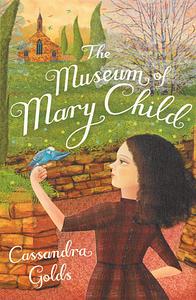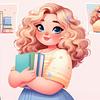Take a photo of a barcode or cover
I wasn't sure where this book was going with elements of fantasy, mystery, and Gothic horror as Heloise searches for love. Sure to go over the heads of many, but the gruesome scary parts will appeal.
I picked up this book when I saw the cover (yes, we DO judge books by their covers!) and I thought it would be really creepy, and good. I was right. I stayed up ALL night reading this book at home, and laid awake at night, wondering what was going to happen to Heloise next. I love these gothic stories, because they are so full of deeper meaning and romantic imagery. I soaked this up. I then pushed it at my mom and told her to read it, and she loves it as much as I do. The only flaw? I wish there was a sequel!
This is such a hard book to categorize. I would love to get this in the hands of a middle schooler to find out what a younger reader thinks/makes of the religious overtones and redemption in this book.
Similar in tone to Guardian of the Gate, it might be a good read-alike for anyone into a darker, more Gothic genre
Similar in tone to Guardian of the Gate, it might be a good read-alike for anyone into a darker, more Gothic genre
A creepy, old-fashioned tale, a mystery, a (non-romantic) love story, a magical fable. Something like that, at least. As someone who reads heavily, I find it particularly refreshing when I have trouble categorizing or describing a book, when I can say it is fairly unique and different. (Not every book has a secret pet network formed to do good called the Society of the Caged Birds of the City, after all.) Particularly when it's a good book that I enjoyed. If you want to be pleasingly intrigued, I suggest you give this one a go.
-----
In any case," she added, "as you ought to know by now, happiness is a Waste of Time. Let me hear no more about it."
-----
For this - this - was love! This closeness, this affection, this protectiveness, this respect, this cherishing, this friendship, this joy between Maria and herself was not charity but love. And this fear of losing her, and the sadness and loneliness that would come if ever she did - that too was love. Love was joy and love was pain. Love was allowing someone to matter to you. Not for their usefulness to you, or even for your usefulness to them, but for no reason, except that they were they and you were you. Love was everything, all that mattered. And yet, in a strange way, her godmother had been right. for love was a kind of folly, a losing game. The greatest of all Wastes of Time.
But then, that depended on what you thought time was for.
-----
And thus it was that Heloise discovered that there were stories apart from the ones in the Bible, stories of magic lamps, flying carpets and caves full of treasure.
But she was not surprised.
Stories were everywhere, she knew that now.
She was beginning to think that, in all the world, there were really only two things - just two. The stories you knew, and the stories you did not know.
-----
"How do stories that begin with 'Once upon a time' end?" she asked. . . .
"With and they all lived happily ever after," he said huskily.
"I don't know the end of the story," said Heloise. "Or at least, I don't know how to get to 'and they all lived happily ever after.' But you do. I know it. Please. Tell me how."
-----
In any case," she added, "as you ought to know by now, happiness is a Waste of Time. Let me hear no more about it."
-----
For this - this - was love! This closeness, this affection, this protectiveness, this respect, this cherishing, this friendship, this joy between Maria and herself was not charity but love. And this fear of losing her, and the sadness and loneliness that would come if ever she did - that too was love. Love was joy and love was pain. Love was allowing someone to matter to you. Not for their usefulness to you, or even for your usefulness to them, but for no reason, except that they were they and you were you. Love was everything, all that mattered. And yet, in a strange way, her godmother had been right. for love was a kind of folly, a losing game. The greatest of all Wastes of Time.
But then, that depended on what you thought time was for.
-----
And thus it was that Heloise discovered that there were stories apart from the ones in the Bible, stories of magic lamps, flying carpets and caves full of treasure.
But she was not surprised.
Stories were everywhere, she knew that now.
She was beginning to think that, in all the world, there were really only two things - just two. The stories you knew, and the stories you did not know.
-----
"How do stories that begin with 'Once upon a time' end?" she asked. . . .
"With and they all lived happily ever after," he said huskily.
"I don't know the end of the story," said Heloise. "Or at least, I don't know how to get to 'and they all lived happily ever after.' But you do. I know it. Please. Tell me how."
The Museum of Mary Child is a complex book. Golds makes you work hard to keep track of what's happening, but there is a huge payoff at the end - an open-mouth, OMG, ending!
Heloise is, well, unusual - as is her family. There is something being hidden, something strange, something sort of creepy. But the creepy feeling isn't apparent at the start of the book. It's only as you read on that you become more and more unsettled.
Recommended for readers who like to be challenged.
Heloise is, well, unusual - as is her family. There is something being hidden, something strange, something sort of creepy. But the creepy feeling isn't apparent at the start of the book. It's only as you read on that you become more and more unsettled.
Recommended for readers who like to be challenged.
Awards Won: Aurealis Award Nominee for Best Young Adult Novel (2009)
Reading level: Young Adult
This book was fairly different than anything that I have ever read. The cover is misleading, and I thought that the book was a true story, or at least based on one. I have since found that there is another addition of the story with a different cover, which I feel is far more suited for the story.
Surprisingly, The Museum of Mary Child is a mix of both fantasy and realistic fiction. The two genres almost seem like separate entities until the climax of the story. Also, I feel that the story was definitely too macabre for middle grade students, though I feel that the plot might not be very appealing to young adults. The story centers around dolls, which would appeal to a younger audience.
As an adult I quite enjoyed the story of Mary Child, though I am not certain that most children or young adults would share my opinion. This book is definitely designed for a special type of reader.
Reading level: Young Adult
This book was fairly different than anything that I have ever read. The cover is misleading, and I thought that the book was a true story, or at least based on one. I have since found that there is another addition of the story with a different cover, which I feel is far more suited for the story.
Surprisingly, The Museum of Mary Child is a mix of both fantasy and realistic fiction. The two genres almost seem like separate entities until the climax of the story. Also, I feel that the story was definitely too macabre for middle grade students, though I feel that the plot might not be very appealing to young adults. The story centers around dolls, which would appeal to a younger audience.
As an adult I quite enjoyed the story of Mary Child, though I am not certain that most children or young adults would share my opinion. This book is definitely designed for a special type of reader.
A strange story that's both creepy and sweet - recommended.
The Museum of Mary Child was born from a nightmare, and it resonates with my own fears. It is also an exquisite, lyrical fable/fairy tale/story/whatever you want to characterise it as. As usual with Cassandra Golds' books, it made me cry and it made me want to hug it.
adventurous
dark
hopeful
mysterious
medium-paced
Plot or Character Driven:
A mix
Strong character development:
Yes
Loveable characters:
Complicated
Diverse cast of characters:
Complicated
Flaws of characters a main focus:
Yes
It might be due to nostalgia that I enjoyed this more a second time around, but I found I could understand the topics of the story easier than when I first read it.
Graphic: Emotional abuse



